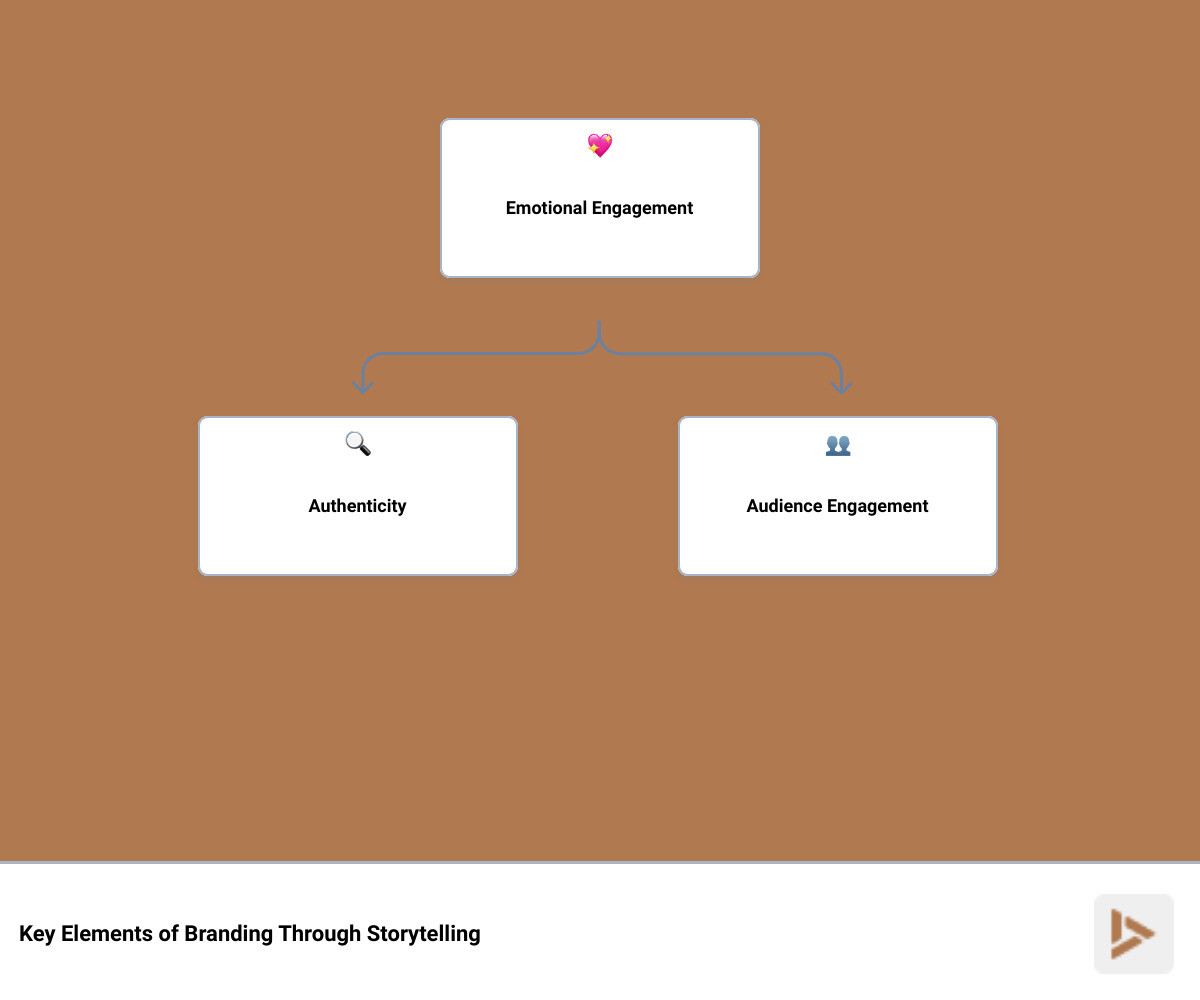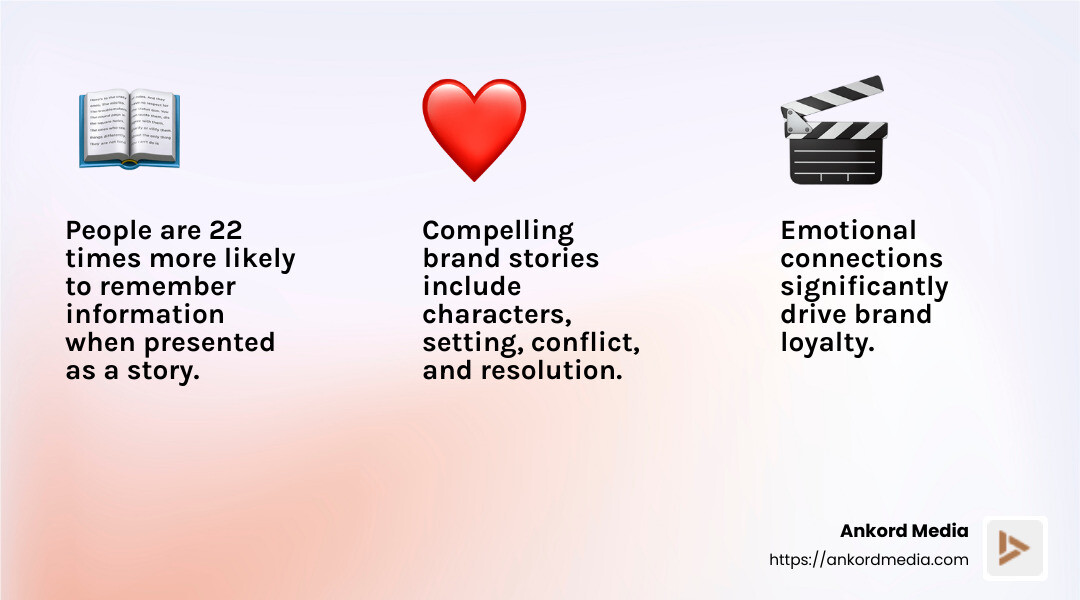Weaving Stories: How to Elevate Your Brand with Storytelling

Branding through storytelling is a powerful tool that businesses use to create lasting impressions and foster deep emotional connections with customers. By weaving narratives that resonate, brands transform from mere entities into experiences that engage and inspire loyalty.
If you're curious about branding through storytelling, here's a quick takeaway:- Build genuine connections: Storytelling creates emotional ties with your audience.- Stand out in the crowd: In a busy market, a great story helps your brand get noticed.- Drive meaningful engagement: Engage your audience, turning them into loyal advocates.
Effective brand storytelling is anchored in authenticity and human connection. As Maya Angelou wisely noted, people will never forget how your brand makes them feel.
I'm Milan Kordestani, a passionate storyteller and expert in branding through storytelling. With experience in crafting memorable narratives at Ankord Media and a history of innovative projects, I’ve seen how stories lift brands and drive growth.

Understanding Branding Through Storytelling
Branding through storytelling is more than just sharing your company's history. It's about creating emotional connections with your audience. When done right, it can transform your brand from a faceless entity into a relatable, memorable presence.
Emotional Connections
Stories are powerful because they tap into emotions. Jerome Bruner, a psychologist, found that people are 22 times more likely to remember information when it's presented as a story rather than as mere facts or figures. This emotional imprint is what makes storytelling such an effective tool in branding.
When your brand tells a story that resonates with its audience, it creates a bond. Customers feel understood and valued, which fosters loyalty. They don't just buy a product; they buy into a narrative that aligns with their own values and experiences.
Brand Loyalty
Emotional connections lead to brand loyalty. A study in the Harvard Business Review highlights that emotional connections are significant drivers of brand loyalty. Customers who feel emotionally connected to a brand are not only more likely to make repeat purchases but also to become advocates for the brand, sharing their positive experiences with others.
Consider the example of Compare the Market's meerkat character, Aleksandr Orlov. By crafting a whimsical storyline around this character, the company built a loyal following who eagerly anticipated each new installment of the meerkat's trips. This approach not only entertained but also strengthened the brand's connection with its audience.
Narrative Techniques
The secret sauce of effective brand storytelling lies in using classic narrative techniques. Just like your favorite movies or books, a compelling brand story includes essential elements:
- Characters: Who is the hero of your story? It could be your customers, your team, or even a symbolic character like Aleksandr Orlov.
- Setting: Where does your story take place? This could be the real-world context of your industry or a metaphorical landscape that represents your brand's journey.
- Conflict and Climax: What challenges does your hero face, and how do they overcome them? This creates tension and keeps your audience engaged.
- Resolution: How does the story end? Ideally, it should reinforce the values and mission of your brand.
By weaving these elements into your brand story, you create a narrative that not only captures attention but also resonates on a deeper level.

In the next section, we'll dig into the four pillars of brand storytelling: people, places, purpose, and plot. These are the building blocks that will help you craft a story that stands out and truly connects with your audience.
The Four Pillars of Brand Storytelling
To create a compelling brand story, you need to focus on four key elements: people, places, purpose, and plot. These pillars form the foundation of effective brand storytelling, helping you connect with your audience on a deeper level.
People
At the heart of every great story are the people involved. In branding through storytelling, these can be your customers, employees, or even fictional characters that represent your brand values.
Consider the case of GEICO's Gecko. This character isn't just a cute mascot; it embodies the company's approachable and friendly brand personality. By using relatable characters, you help your audience see themselves in your story, fostering an emotional connection.
Places
The setting of your story is just as important as the characters. It provides context and helps ground your narrative in reality. Places can be physical locations, like a hometown or a busy city, or they can be metaphorical, representing the journey your brand or customers are on.
For instance, Whole Foods uses storytelling to emphasize its commitment to sustainability and community. By focusing on local experiences and environmental stewardship, the company creates a narrative that resonates with its audience.
Purpose
Every brand story needs a clear purpose. This is the "why" behind your brand's existence. It should align with your core values and mission, giving your audience a reason to care about your story.
Take Dove, for example. Its brand purpose—to help women develop a positive relationship with how they look—is woven into every campaign. This purpose-driven approach not only differentiates Dove from its competitors but also builds a loyal community around shared values.
Plot
Finally, a well-crafted plot is essential to keep your audience engaged. Your brand story should have a clear beginning, middle, and end, with challenges and resolutions that mirror your audience's experiences.
Consider Coca-Cola's Ramadan ad, which follows a young Muslim woman's journey through a busy city. The plot highlights her struggles and the kindness of a stranger, culminating in a moment of shared understanding. This narrative not only promotes the product but also reinforces Coca-Cola's message of unity.
By focusing on people, places, purpose, and plot, you can craft a brand story that not only captures attention but also resonates with your audience on a deeper level. In the next section, we'll explore how to craft a compelling brand story by focusing on your target audience, core values, and authenticity.
How to Craft a Compelling Brand Story
Crafting a compelling brand story begins with understanding your target audience. Your story should speak directly to them, addressing their needs, desires, and challenges. This means getting to know who they are, what they care about, and what motivates them. By doing so, you can tailor your narrative to resonate with them on a personal level.
Core values are the backbone of your brand story. They define what your brand stands for and guide every decision you make. When your story aligns with your core values, it becomes more than just a marketing tool—it becomes a reflection of your brand's identity. Consider how Fire Department Coffee incorporates its founder's background as a firefighter and veteran into its story, connecting deeply with its audience through shared values of service and dedication.
Authenticity is crucial in branding through storytelling. Your audience can tell when a story is genuine and when it's not. Being honest about your brand's journey, including the challenges you've faced and how you've overcome them, builds trust. As Louis Richardson, a storytelling pro, emphasizes, "It's not about getting them to buy. It's about getting them to believe."
To create an authentic story, avoid jargon and speak in a language your audience understands. Use relatable scenarios that mirror their experiences. This not only makes your story more engaging but also helps your audience see themselves in it, fostering a deeper emotional connection.
In summary, a compelling brand story is one that understands its audience, is grounded in core values, and is told with authenticity. By focusing on these elements, you can craft a narrative that not only captures attention but also builds lasting relationships with your audience.
Branding Through Storytelling: Best Practices
When it comes to branding through storytelling, there are a few best practices that can help you tell your story effectively and consistently.
Consistency
Consistency is key. Your brand story should be the same across all platforms—whether it's your website, social media, or email marketing. This uniformity helps build trust and recognition. People like knowing what to expect. If your tone, visuals, or message changes too often, it can confuse your audience and weaken your brand.
Think of your brand story as a thread that weaves through every piece of content you create. Use tools like a content management system (CMS) or a digital asset management (DAM) solution to keep everything aligned and on-brand. This ensures that every piece of content supports your story and keeps your identity intact.
Customer Involvement
Your customers are not just passive listeners; they are active participants in your brand story. Involve them by integrating their experiences and feedback. This can be as simple as sharing customer testimonials or as interactive as hosting a live Q&A session.
Consider the power of reviews. According to research, 45% of shoppers won’t purchase a product if there are no reviews available for it. Incorporating testimonials and case studies into your marketing strategy not only enriches your story but also builds credibility and trust.
Brand Guidelines
Having clear brand guidelines is essential for maintaining consistency and authenticity. These guidelines should cover everything from your tone of voice to visual elements like logos and colors. They act as a roadmap for anyone creating content for your brand, ensuring that all communications are cohesive and true to your story.
Brand guidelines are not just about rules; they are about creating a unified vision that everyone in your company can follow. This helps deliver a consistent experience to your audience, reinforcing your brand identity at every touchpoint.
By focusing on these best practices—consistency, customer involvement, and clear brand guidelines—you can create a powerful narrative that not only tells your story but also engages and inspires your audience.
Frequently Asked Questions about Branding Through Storytelling
How do you write a brand story?
Writing a brand story might seem daunting, but it starts with understanding your target audience. Who are they, and what do they care about? Your story should speak directly to their needs and aspirations.
Next, focus on your core values. These are the principles that guide your brand and differentiate you from competitors. Your brand story should reflect these values in a way that resonates with your audience. By doing so, you create a narrative that is both authentic and compelling.
A brand story is not just a list of facts. It's a narrative that includes a beginning, middle, and end. It should evoke emotion and connect with your audience on a deeper level.
Why is storytelling important in branding?
Storytelling is crucial in branding because it builds emotional connections with your audience. People are more likely to engage with a brand when they feel a personal connection. This emotional engagement fosters brand loyalty, turning one-time customers into repeat buyers.
When you tell a story, you invite your audience into your world. This shared experience makes your brand memorable and helps it stand out in a crowded marketplace.
Consider the success of brands like Nike, which doesn't just sell shoes but sells the idea of overcoming challenges and achieving greatness. Their storytelling approach has made them a leader in emotional branding.
How to use storytelling in branding?
To use storytelling effectively in branding, focus on emotional engagement. Your story should not only inform but also inspire and captivate your audience. Use relatable characters, real-life scenarios, and vivid imagery to make your story come alive.
Incorporate storytelling across all your marketing channels. Whether it's a blog post, social media update, or video, your brand story should be consistent and pervasive. This helps maintain brand loyalty by reinforcing the narrative at every touchpoint.
Engage your audience by inviting them to be part of your story. Encourage them to share their own experiences with your brand. This not only enriches your narrative but also builds a community around your brand.
By focusing on these elements—target audience, core values, emotional connections, and brand loyalty—you can craft a brand story that resonates and inspires, ultimately elevating your brand's presence in the market.
Conclusion
At Ankord Media, we believe that authentic connections are the heart of effective branding. Our approach to branding through storytelling is rooted in creating genuine, emotional bonds between brands and their audiences. We don't just craft stories; we create experiences that resonate on a personal level.
Impactful storytelling is more than just a marketing tool—it's a way to transform bold ideas into reality. By weaving narratives that align with your brand's core values and vision, we help you stand out in a crowded marketplace. This not only boosts visibility but also fosters brand loyalty and trust.
We specialize in partnering with visionary clients who are ready to challenge the status quo. Together, we turn ambitions into success stories. Our focus on strategic branding, cutting-edge design, and technology ensures that your brand's story is not only told but felt.
Join us in crafting a brand narrative that captivates and inspires. Let us help you build lasting connections with your audience through storytelling that truly matters.
For more information on how Ankord Media can lift your brand through storytelling, visit our service page.

